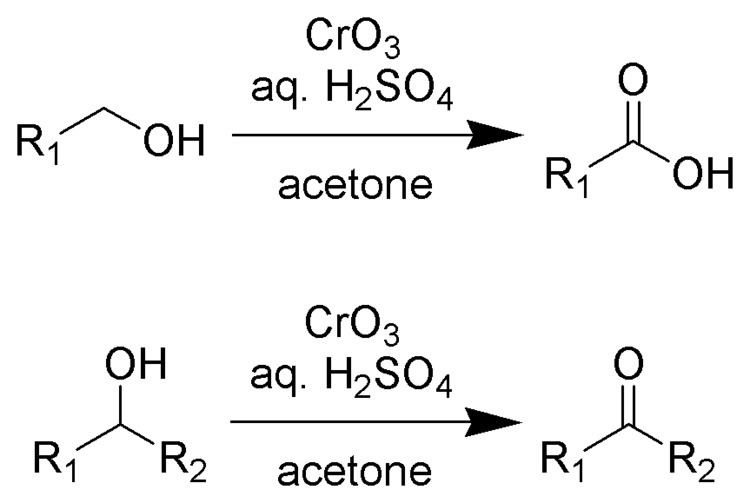Organic Chemistry Portal jones-oxidation | ||
 | ||
The Jones oxidation is an organic reaction for the oxidation of primary and secondary alcohols to carboxylic acids and ketones, respectively. It is named after its discoverer, Sir Ewart Jones.
Contents
Jones reagent is a solution of chromium trioxide in dilute sulfuric acid and acetone. A mixture of potassium dichromate and dilute sulfuric acid can also be used. The solvent acetone markedly affects the properties of the chromic acid. The oxidation is very rapid, quite exothermic, and the yields are typically high. The reagent rarely oxidizes unsaturated bonds.
Stoichiometry
Jones reagent will convert primary and secondary alcohols to aldehydes and ketones, respectively. Depending on the reaction conditions, the aldehydes may then be converted to carboxylic acids. For oxidations to the aldehydes and ketones, two equivalents of chromic acid oxidize three equivalents of the alcohol:
2 HCrO4− + 3 RR'C(OH)H + 8 H+ + 4 H2O → 2 [Cr(H2O)6]3+ + 3 RR'COFor oxidation of primary alcohols to carboxylic acids, one equivalent of Jones reagent is required for each substrate. The aldehyde is an intermediate.
4 HCrO4− + 3 RCH2OH + 16 H+ + 11 H2O → 4 [Cr(H2O)6]3+ + 3 RCOOHThe inorganic products are green, characteristic of chromium(III) aquo complexes.
Mechanism
Like many other oxidations of alcohols by metal oxides, the reaction proceeds via the formation of a mixed ester: These esters have the formula CrO3(OCH2R)−
CrO3(OH)− + RCH2OH → CrO3(OCH2R)− + H2OLike conventional esters, the formation of this chromate ester is accelerated by the acid. These esters can be isolated when the alcohol lacks α-C-H bonds. For example, using tert-butyl alcohol, one can isolate ((CH3)3CO)2CrO2 (which is a good oxidant). The chromate esters degrade, releasing the carbonyl product and an ill-defined Cr(IV) product:
CrO3(OCH2R)− → "CrO2OH−" + O=CHRThe partially deuterated alcohols HOCD2R oxidize about six times slower than the undeuterated derivatives. This large kinetic isotope effect shows that the C–H (or C-D) bond breaks in the rate-determining step. The reaction stoichiometry implicates the Cr(IV) species "CrO2OH−", which comproportionates with the chromic acid to give a Cr(V) oxide, which also functions as an oxidant for the alcohol.
The oxidation of the aldehydes is proposed to proceed via the formation of hemiacetal-like intermediates, which arise from the addition of the O3CrO-H− bond across the C=O bond.
Illustrative reactions and applications
Although useful reagent for some applications, due to the carcinogenic nature of chromium(VI), the Jones oxidation has slowly been replaced by other oxidation methods. It remains useful in organic synthesis. A variety of spectroscopic techniques, including IR can be used to monitor the progress of a Jones Oxidation reaction and confirm the presence of the oxidized product. At one time the Jones oxidation was used in primitive breathalyzers. Aminoindans, which are of pharmalogical interest, are prepared by the oxidation of the alcohol to ketone which is converted into an amino group. The alcohol is oxidized to the ketone with the Jones reagent. The reagent was once used to prepare salicylic acid, a precursor to aspirin. Methcathinone is a psychoactive stimulant that is sometimes used as an addictive recreational drug. It can be oxidized from certain alcohols using the Jones reagent.
Related processes
Several other chromium compounds are used for the oxidation of alcohols. These include Collins reagent and pyridinium chlorochromate The Sarett oxidation is a similar process.
